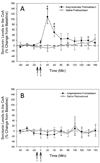Chronic amphetamine treatment enhances corticotropin-releasing factor-induced serotonin release in the amygdala
- PMID: 20655906
- PMCID: PMC2923226
- DOI: 10.1016/j.ejphar.2010.07.008
Chronic amphetamine treatment enhances corticotropin-releasing factor-induced serotonin release in the amygdala
Abstract
Amphetamine use is associated with dysphoric states, including heightened anxiety, that emerge within 24h of withdrawal from the drug. Corticotropin-releasing factor increases serotonin release in the central nucleus of the amygdala, and this neurochemical circuitry may play a role in mediating fear and anxiety states. We have previously shown that chronic amphetamine treatment increases corticotropin-releasing factor receptor type-2 levels in the serotonergic dorsal raphe nucleus of the rat. Therefore, we hypothesized that chronic amphetamine treatment would enhance the amygdalar serotonergic response to corticotropin-releasing factor infused into the dorsal raphe nucleus. Male rats were injected once-daily with d-amphetamine (2.5mg/kg i.p., or saline) for two weeks. Serotonin release within the central nucleus of the amygdala in response to intra-raphe infusion of corticotropin-releasing factor (100 ng) was measured 24h after the last treatment in urethane-anesthetized (1.8 mg/kg, i.p.) rats using in vivo microdialysis. Rats pretreated with amphetamine showed significantly enhanced serotonin release in the central nucleus of the amygdala in response to corticotropin-releasing factor infusion when compared to saline pretreated rats. Furthermore, this enhanced response was blocked by the corticotropin-releasing factor type-2 receptor antagonist antisauvagine-30 (2 microg) infused into the dorsal raphe nucleus. These results suggest increased sensitivity to corticotropin-releasing factor as mediated by type-2 receptors following chronic amphetamine treatment, which may underlie dysphoric states observed during amphetamine withdrawal.
Copyright 2010 Elsevier B.V. All rights reserved.
Figures





Similar articles
-
Corticotropin-releasing factor in the dorsal raphe nucleus increases medial prefrontal cortical serotonin via type 2 receptors and median raphe nucleus activity.Eur J Neurosci. 2008 Jul;28(2):299-310. doi: 10.1111/j.1460-9568.2008.06333.x. Eur J Neurosci. 2008. PMID: 18702701 Free PMC article.
-
Corticotropin-releasing factor 1 and 2 receptors in the dorsal raphé differentially affect serotonin release in the nucleus accumbens.Eur J Pharmacol. 2008 Jan 14;578(2-3):185-93. doi: 10.1016/j.ejphar.2007.09.024. Epub 2007 Oct 2. Eur J Pharmacol. 2008. PMID: 17945210 Free PMC article.
-
Restraint stress increases serotonin release in the central nucleus of the amygdala via activation of corticotropin-releasing factor receptors.Brain Res Bull. 2008 Jul 30;76(5):493-8. doi: 10.1016/j.brainresbull.2008.02.011. Epub 2008 Mar 4. Brain Res Bull. 2008. PMID: 18534257 Free PMC article.
-
Stressor controllability and learned helplessness: the roles of the dorsal raphe nucleus, serotonin, and corticotropin-releasing factor.Neurosci Biobehav Rev. 2005;29(4-5):829-41. doi: 10.1016/j.neubiorev.2005.03.021. Neurosci Biobehav Rev. 2005. PMID: 15893820 Review.
-
Ethanol and corticotropin releasing factor receptor modulation of central amygdala neurocircuitry: An update and future directions.Alcohol. 2015 May;49(3):179-84. doi: 10.1016/j.alcohol.2015.01.006. Epub 2015 Jan 29. Alcohol. 2015. PMID: 25716197 Free PMC article. Review.
Cited by
-
Amphetamine Withdrawal Differentially Increases the Expression of Organic Cation Transporter 3 and Serotonin Transporter in Limbic Brain Regions.J Exp Neurosci. 2016 Jul 21;10:93-100. doi: 10.4137/JEN.S40231. eCollection 2016. J Exp Neurosci. 2016. PMID: 27478387 Free PMC article.
-
Influence of chronic amphetamine treatment and acute withdrawal on serotonin synthesis and clearance mechanisms in the rat ventral hippocampus.Eur J Neurosci. 2013 Feb;37(3):479-90. doi: 10.1111/ejn.12050. Epub 2012 Nov 14. Eur J Neurosci. 2013. PMID: 23157166 Free PMC article.
-
Iron Oxide Nanoparticle Delivery of Peptides to the Brain: Reversal of Anxiety during Drug Withdrawal.Front Neurosci. 2017 Nov 1;11:608. doi: 10.3389/fnins.2017.00608. eCollection 2017. Front Neurosci. 2017. PMID: 29163012 Free PMC article.
-
Corticotropin-releasing factor-related peptides, serotonergic systems, and emotional behavior.Front Neurosci. 2013 Sep 20;7:169. doi: 10.3389/fnins.2013.00169. Front Neurosci. 2013. PMID: 24065880 Free PMC article. Review.
-
Dissociation of corticotropin-releasing factor receptor subtype involvement in sensitivity to locomotor effects of methamphetamine and cocaine.Psychopharmacology (Berl). 2012 Feb;219(4):1055-63. doi: 10.1007/s00213-011-2433-y. Epub 2011 Aug 11. Psychopharmacology (Berl). 2012. PMID: 21833501 Free PMC article.
References
-
- Amat J, Tamblyn JP, Paul ED, Bland ST, Amat P, Foster AC, Watkins LR, Maier SF. Microinjection of urocortin 2 into the dorsal raphe nucleus activates serotonergic neurons and increases extracellular serotonin in the basolateral amygdala. Neuroscience. 2004;129:509–519. - PubMed
-
- Amsterdam JD, Hornig-Rohan M, Maislin G. Efficacy of alprazolam in reducing fluoxetine-induced jitteriness in patients with major depression. J Clin Psychiatry. 1994;55:394–400. - PubMed
-
- Artaiz I, Zazpe A, Del Rio J. Characterization of serotonergic mechanisms involved in the behavioural inhibition induced by 5-hydroxytryptophan in a modified light-dark test in mice. Behavioural Pharmacol. 1998;9:103–112. - PubMed
-
- Bale TL. Sensitivity to stress: dysregulation of CRF pathways and disease development. Horm. Behav. 2005;48:1–10. - PubMed
-
- Barr AM, Markou A. Psychostimulant withdrawal as an inducing condition in animal models of depression. Neurosci. Biobehav. Rev. 2005;29:675–706. - PubMed
Publication types
MeSH terms
Substances
Grants and funding
LinkOut - more resources
Full Text Sources
Molecular Biology Databases

